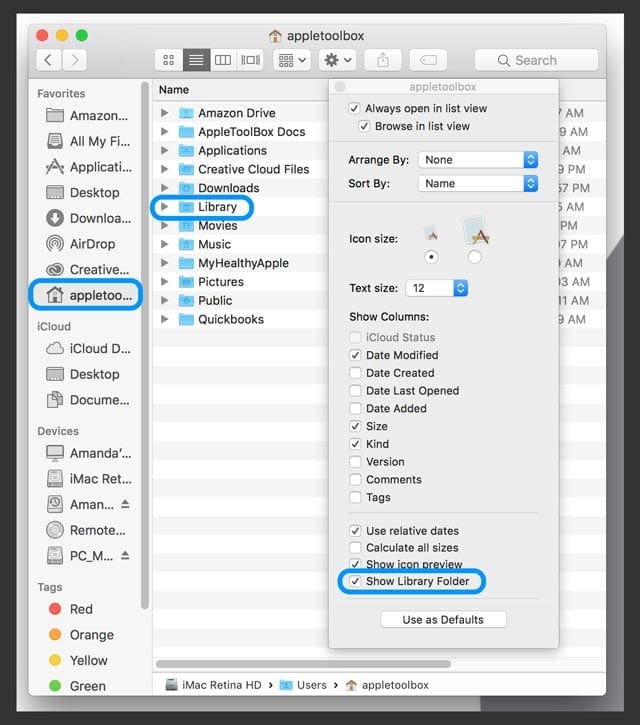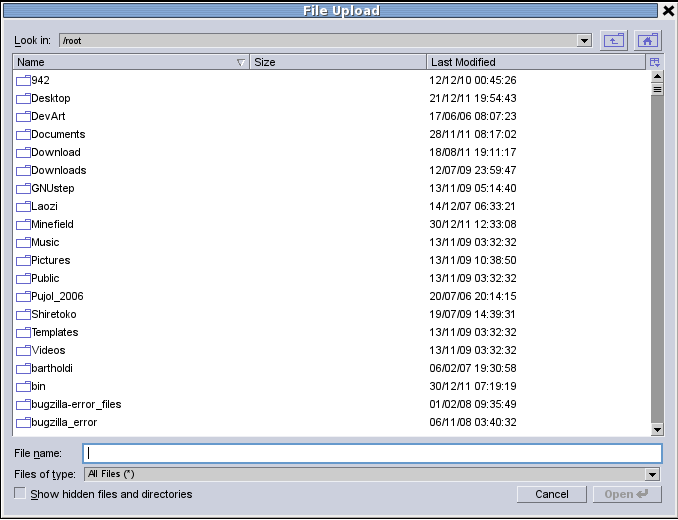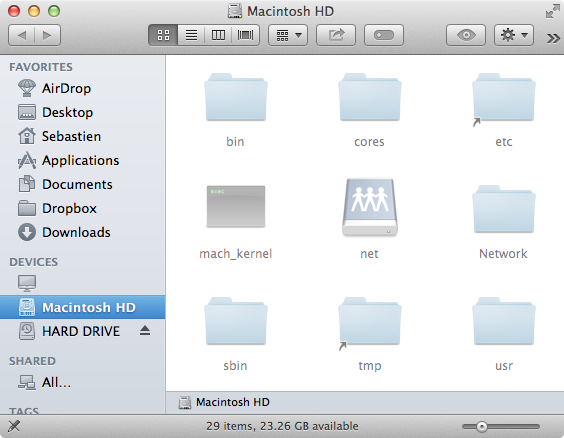- Mac Os Show Hidden Files Permanently Deleted
- Show All Files Mac Os
- How To Show Hidden Files Mac Mojave/Catalina/High Sierra
How To Show Hidden Files In MacOS Finder 1. Press Command + Shift +. Open MacOS finder and go to your desired folder. Then press Command + Shift +. Enable Show Hidden Files Permanently By Script Alias. Then, click on ‘OK.' Now, you can view the hidden files and folders. Again, you can hide them again through the same process. How To View Hidden Files On A USB Or External Hard Drive In Mac: In Mac OS, you have to take advantage of Terminal to reveal or view hidden files or folders in the device. Terminal is the native command-line tool.
The easiest way to reveal hidden files and folders in an active Finder window is to press the Shift, Command (⌘), and period symbol (.) keys in combination. This action works everywhere except for. Show Hidden Files or ShowHiddenFiles (was ChangeVisibility) enables you to change the visibility flag for files in all versions of OS X. It's easy to use, with a simple GUI. Much easier than using Terminal if you have to change file and folder visibility frequently. Even reveals files with chflags hidden applied to them. However, removing the hidden attribute (chflags nohidden file.txt) in the Terminal does not dynamically unhide the file in an open Finder window. The Finder window must be closed and reopened to show the newly unhidden file.
Mac Os Show Hidden Files Permanently Deleted
| Click here to return to the 'Permanently Unhide Library' hint |
A simple thing I did was to unhide the Library folder and then drag it into my Sidebar. Even if an update hides it again, it's just one click away.
Or make an alias of the '~/Library' folder called '~/Library .'
I thought this was a big deal until I actually got Lion and found that option-clicking on the 'Go' Menu item it was there in the list. that's easy enough for me.
This should be the hint.
Show All Files Mac Os
I simply can't imagine that a person needs to access that folder often enough to justify un-hiding it. You can easily access the Library when you need it by holding 'option' and choosing Library from the Finder's Go menu.
As a software developer, I definitely need immediate access to this folder, preferable in the way I have always had access to it, by simply double-clicking the folder.
Mark
Economy-x-Talk
Have your own custom software created
http://economy-x-talk.com
This is interesting. I made my Library folder visible when I first installed Lion, and it has stayed that way through every update. I can't remember what method I used though.
Here's a launchd plist that will do the same thing, but without the need for AppleScript, login items, etc. Just drop it in /Library/LaunchDaemons and set the permissions properly.
Label
local.library.nohidden
ProgramArguments
/usr/bin/chflags
nohidden
/Users/*/Library
RunAtLoad
EnableGlobbing
StandardErrorPath
/dev/null
Using the Option-Go menu is fine for the occasional use, but that doesn't work in File dialogs. VERY irritating that they reset this flag for updates or even feel the need to hide it in the first place.
All I do is run the command: $chflags nohidden ~/Library/ There is no need for //usr/bin/ (as mentioned in the previous hint) Then, browse to the folder in the Finder, drag it over into the sidebar, then do the command again. Only this time making it hidden: $chflags hidden ~/Library/ Then, it won't be visible in my ~ folder anymore, but it will still be perfectly accessible from the sidebar.
Your Mac has a secret. Thousands of them in fact, in the form of hidden files and folders lurking on its hard drive or SSD. Don't worry, though. These files and folders are all supposed to be there. In fact, many of them are essential.
Many of these files are in your Mac's main Library folder or in the ~/Library folder, which is in your User folder. Both these Library folders are hidden, but inside them are folders and files that hold things like preferences for apps.
Hp 2013 ultraslim docking station drivers. Download the latest drivers, firmware, and software for your HP 2013 UltraSlim Docking Station.This is HP's official website that will help automatically detect and download the correct drivers free of cost for your HP Computing and Printing products for Windows and Mac operating system. Find support and troubleshooting info including software, drivers, and manuals for your HP 2013 UltraSlim Docking Station. Dock the notebook unit to the HP Ultraslim Docking Station. Connect a monitor to the docking station DP port using the native DisplayPort or a DP-to-VGA adapter on the dock DP port. Then make sure the monitor is enabled (powered on) from the Windows Display Manager. Install the latest driver for HP 2013 ultraslim docking station firmware. Download the latest and official version of drivers for HP 2013 UltraSlim Docking Station. This driver package is available for 32 and 64 bit PCs. It is compatible with the following operating Systems: Windows. Don't worry if you don't know what's your operating system.
In this article, we'll tell you how you can view hidden files on your Mac and make your Library folder visible.

What are the hidden files on Mac?

The hidden files are a throwback to macOS' Unix roots. In fact, the convention of naming them starting with a '.' comes from Unix. For that reason, you can't use a '.' at the start of a regular file name, otherwise OS X will hide it.
The files themselves contain data like access rights and privileges for files and folders, application support files, and preferences.
There are a number of reasons files and folders are hidden. Mostly, though, it's because they contain data critical to the smooth running of your Mac and that you shouldn't interfere with. In addition, there's no real reason for most users to see or access them. Also, if they were all visible, your Mac would look horribly cluttered.
How to view hidden files on Mac
Before you make your Mac show hidden files, it's important to remember they've been hidden for a reason. The data they contain could cause havoc if you delete or alter it and don't know what you're doing.
If your goal in viewing, for example ~/Library is so you can manually delete application support files for a program you've uninstalled, consider using a dedicated uninstaller like CleanMyMac X. That will make it easy to remove all the files associated with an application with one click. You can download CleanMyMac X for free here.
CleanMyMac X will also allow you to get rid of all the hidden files you no longer need. Many of these files are created and used then not needed anymore. They just sit there clogging up your hard drive. CleanMyMac X scans your Mac, identifies this system junk and allows you to quickly and easily get rid of it, potentially several gigabytes of disk space.
How To Show Hidden Files Mac Mojave/Catalina/High Sierra
If you still want to view hidden files on your Mac, you need to go to the Finder and do the following:
- Open a new Finder window and click on the name of your Mac under ‘Devices' in the sidebar.
- Click on Macintosh HD, or whatever you've called your startup drive if you've renamed it.
- Press Command-Shift-. (period). You should now see lots of files and folders who's name starts with '.' become visible.
- To re-hide the files and folders, hold down Command-Shift-. again.
How to view your Mac's ~/Library folder
There are a couple of methods for making your ~/Library folder visible. Here's the simplest:
- Click on the Finder in the Dock.
- Open a new Finder window and navigate to your user folder (Tip: if it's not in the sidebar, go to the Finder menu, choose Preferences, click Sidebar and check the box next to your Home folder)
- Click on the Go menu.
- Hold down the Option (Alt) key.
- You should see that in the dropdown menu, Library appears below Home. Click on it.
Alternatively, do this to view your Library folder:
- Click on the Finder in the Dock.
- Click on the Go menu and choose Go to Folder.
- In the window that opens, type '~/Library'
With both these methods, your Library folder will disappear again when you close the Finder window. It's easy enough to run through the steps above again to make it visible again when you need to, but if you want it permanently accessible, there are a couple of ways to do it.

The quickest is to drag the Library folder to the Finder's sidebar. That will create a shortcut to it that will persist. If you want to keep ~/Library visible but don't want it clogging up the sidebar in Finder windows, do this:
- Click on the Finder in the Dock.
- Click on the View menu and choose Show View Options.
- Check the box labelled Show Library Folder at the bottom of the window.
How to make macOS show hidden files using Terminal
If you're feeling particularly adventurous, you can use the Terminal command line interface to view hidden files and folders. Here's how to do it:

What are the hidden files on Mac?
The hidden files are a throwback to macOS' Unix roots. In fact, the convention of naming them starting with a '.' comes from Unix. For that reason, you can't use a '.' at the start of a regular file name, otherwise OS X will hide it.
The files themselves contain data like access rights and privileges for files and folders, application support files, and preferences.
There are a number of reasons files and folders are hidden. Mostly, though, it's because they contain data critical to the smooth running of your Mac and that you shouldn't interfere with. In addition, there's no real reason for most users to see or access them. Also, if they were all visible, your Mac would look horribly cluttered.
How to view hidden files on Mac
Before you make your Mac show hidden files, it's important to remember they've been hidden for a reason. The data they contain could cause havoc if you delete or alter it and don't know what you're doing.
If your goal in viewing, for example ~/Library is so you can manually delete application support files for a program you've uninstalled, consider using a dedicated uninstaller like CleanMyMac X. That will make it easy to remove all the files associated with an application with one click. You can download CleanMyMac X for free here.
CleanMyMac X will also allow you to get rid of all the hidden files you no longer need. Many of these files are created and used then not needed anymore. They just sit there clogging up your hard drive. CleanMyMac X scans your Mac, identifies this system junk and allows you to quickly and easily get rid of it, potentially several gigabytes of disk space.
How To Show Hidden Files Mac Mojave/Catalina/High Sierra
If you still want to view hidden files on your Mac, you need to go to the Finder and do the following:
- Open a new Finder window and click on the name of your Mac under ‘Devices' in the sidebar.
- Click on Macintosh HD, or whatever you've called your startup drive if you've renamed it.
- Press Command-Shift-. (period). You should now see lots of files and folders who's name starts with '.' become visible.
- To re-hide the files and folders, hold down Command-Shift-. again.
How to view your Mac's ~/Library folder
There are a couple of methods for making your ~/Library folder visible. Here's the simplest:
- Click on the Finder in the Dock.
- Open a new Finder window and navigate to your user folder (Tip: if it's not in the sidebar, go to the Finder menu, choose Preferences, click Sidebar and check the box next to your Home folder)
- Click on the Go menu.
- Hold down the Option (Alt) key.
- You should see that in the dropdown menu, Library appears below Home. Click on it.
Alternatively, do this to view your Library folder:
- Click on the Finder in the Dock.
- Click on the Go menu and choose Go to Folder.
- In the window that opens, type '~/Library'
With both these methods, your Library folder will disappear again when you close the Finder window. It's easy enough to run through the steps above again to make it visible again when you need to, but if you want it permanently accessible, there are a couple of ways to do it.
The quickest is to drag the Library folder to the Finder's sidebar. That will create a shortcut to it that will persist. If you want to keep ~/Library visible but don't want it clogging up the sidebar in Finder windows, do this:
- Click on the Finder in the Dock.
- Click on the View menu and choose Show View Options.
- Check the box labelled Show Library Folder at the bottom of the window.
How to make macOS show hidden files using Terminal
If you're feeling particularly adventurous, you can use the Terminal command line interface to view hidden files and folders. Here's how to do it:
- Open Terminal from the Utilities folder in Applications, or by searching for it using Spotlight. You can also use the Go menu in the Finder to go directly to the Utilities folder.
- Type, or copy and paste, this command: defaults write com.apple.Finder AppleShowAllFiles true
- Press Return
- Type: killall Finder
To hide the files again, repeat the above steps, but replace ‘true' with ‘false' at the end of step 2.
How to hide any file or folder using Terminal
Now that you know how to view hidden files and folders on your Mac, you may be wondering how you can hide other files or folders, to keep them away from prying eyes. There are a number of third-party applications and utilities that offer to do this for you, but you can do it yourself in Terminal, like this:
- Launch Terminal.
- Type: chflags hidden
- Press the spacebar.
- Drag the file or folder you want to hide from the Finder onto the Terminal window.
- You'll see the path to the file or folder displayed in Terminal after the command you typed.
- Hit Return to execute the command.
The file or folder you dragged onto the Terminal window will now be hidden. To see it again, use one of the methods described above to see hidden files.
To make the file visible permanently again, use the steps above, but in step 2 type: chflags nohidden
As you can see, viewing hidden files and folders on your Mac is very straightforward. There are a number of ways to do it, and you can make them visible temporarily or permanently.
However, just because you can view hidden files, doesn't mean you should — the files are usually hidden because accidentally deleting them or altering them could cause chaos on your Mac. So, while it's fine to have a peek, don't do anything with the hidden files unless you know what you're doing.
If you want to declutter your Mac or uninstall applications, use a dedicated application like CleanMyMac X. It will safely remove all useless files, add-ons, broken login items, caches, large and old files you didn't know about. Most likely, you won't even need to look for hidden files — CleanMyMac will do all the job for you.
We also showed that many of those files are stored in Library folders, including the one in your User folder, ~/Library. That folder is hidden by default, but you can view it or make it permanently visible using the techniques described above.
